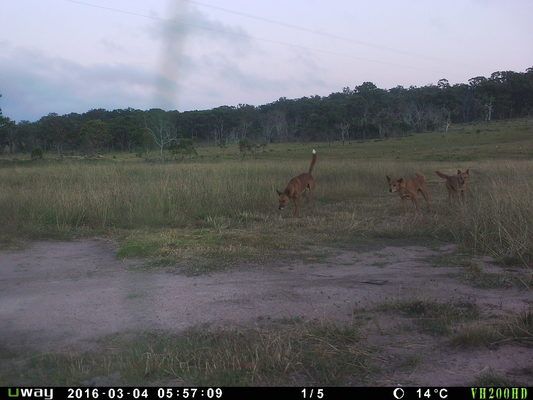THE war on wild dogs continues to be waged in the Southern Downs with the next round of the invasive pest control program, including aerial and ground activities, to begin this week.
Southern Downs Regional Council will lead another aerial baiting operation this week (Wednesday and Thursday) in conjunction with Goondiwindi Regional Council and Biosecurity Queensland.
This round of aerial baiting will target inaccessible areas that provide habitat for wild dogs in Goldfields, Pikedale, Springdale, Mingoola, Ballandean, Cement Mills and Gore.
Southern Downs pest management officer Craig Magnussen said 3500kg of 1080 meat bait has been prepared for distribution over 350 kilometres of flight lines.
“A number of different meat sources are being used, including feral deer and kangaroo,” Mr Magnussen said.
The feral deer and kangaroo are sourced through a Stanthorpe-based, food safe accredited processer, and this is serving an additional role in helping to reduce local populations of those animals.
“A Robinson 66 helicopter from Goondiwindi Helicopters will be used to distribute the baits, with officers from Southern Downs and Goondiwindi regional councils, Biosecurity Queensland and local landholders providing the manpower.”
Wild dog activity has been very low in most of the areas previously aerial baited in April this year. Landholder reports and monitoring sites maintained by Southern Downs Regional Council suggest numbers remain low, but are building, with a number of heavily pregnant bitches being captured on remote cameras.
Mr Magnussen said now was the opportune time to hit them again.
“We need to take out these wild dogs to ensure their progeny do not survive and disperse further afield,” he said.
“The team has attempted to refine bait lines by taking in some previously unbaited inaccessible country on both private lands and in some National Park/State Forest areas.”
In addition to aerial baiting, the council will carry out ground-baiting activities in northern parts of the region from 14 to 16 September.
Southern Downs pest management officer James Eastwell said the most efficient and effective form of broad-scale wild dog control was regular, co-ordinated ground baiting targeting accessible areas where dogs may travel, feed and water.
“The key to effective wild dog control is achieving high participation by landholders in baiting programs in areas where wild dogs are living and breeding,” Mr Eastwell said.
“The council provides a free baiting service to landholders and organises between four and six co-ordinated ground baiting campaigns each year.
“These campaigns are timed to co-incide with wild dog mating and breeding cycles, and aerial baiting and other councils’ baiting activities to provide the most comprehensive control.
“Thye council works with a number of landholders that act as co-ordinators for their areas to communicate when baiting is going to occur and to encourage more participation.
“Landholders provide their own meat bait for ground baiting and the council provides the 1080 injection service. The landholders distribute the baits on their own properties as they know their country best.”
Southern Downs rural, environmental, sustainability and waste management portfolio councillor Cameron Gow highlighted that while there had been good co-operation from the majority of private landholders in the baiting programs, there remained a small percentage of landholders that would not participate, to the detriment of other landholders across the region.
“In general the majority of landholders have been on board in support of the baiting program through the Queensland Feral Pest Initiative.
“However, we’re particularly concerned about the Queensland Parks and Wildlife Service’s control measure policies that ignore evidence-based knowledge of wild dog ecology and migration patterns.
“It’s critically important that the State Government takes responsibility to control pest animals in their National Parks and State Forests.
“They are not implementing best practice control methods such as aerial baiting in inaccessible areas, and are placing the onus on adjoining landholders to prove why the department should undertake controls in its National Parks and State Forests.
“For wild dog and other invasive pest animal control programs to be effective, they must be co-ordinated, co-operative and broad scale.
“The financial and social wellbeing impacts on primary producers through livestock losses from wild dog attacks is considerable, and our region has already seen some of the flow-on effects with the recent closure of the Wallangarra Meatworks due in part, to the lack of supply of sheep.
“Local governments are committing time and resources into best practice pest animal control and it’s time the State Government stepped up and do the same in their National Parks and State Forests, and we will continue to push for greater co-operation.”
Funding for the Southern Downs Regional Council Queensland Feral Pest Initiative project is provided through the Queensland Government to support the growth of a productive and prosperous food and fibre sector in Queensland.
Funding has also been provided through the Australian Government Agricultural Competitiveness White Paper, the Australian Government’s plan for stronger farmers and a stronger economy.
The project is being delivered in partnership with Goondiwindi Regional Council, Granite Borders Landcare Committee and Biosecurity Queensland.







